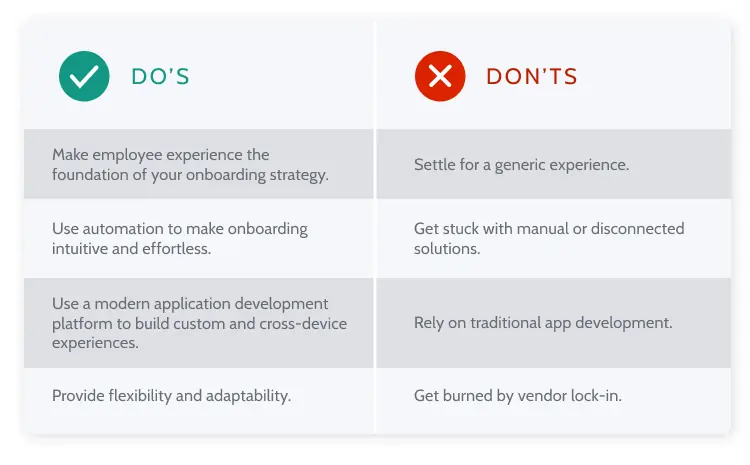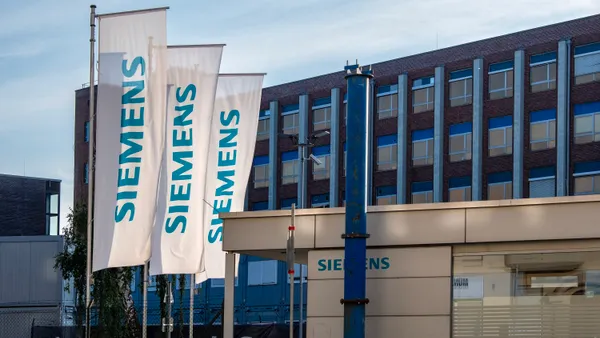In addition to the challenging transformation in our daily life, the COVID-19 pandemic has led to a seismic change in the employment market, which many experts speculate will become permanent.
Talented prospects are now choosier than ever, selecting employers that respect their time and abilities, meet their needs for a modern experience, and provide tools that make their work more efficient, productive, and pleasant. It's all about becoming an employer of choice known for offering an exceptional employee experience (EX).
First impressions matter, making onboarding a critical stage in the employee lifecycle.
In fact, employee turnover can be as much as 50% in the first four months for hourly workers, and 50% in the first 18 months for senior hires. Onboarding represents your new employees’ first introduction with your company, and a good experience can increase employee retention and productivity.
Case in point: Of employees who went through effective onboarding, 91% felt strong connectedness at work. It's essential to get onboarding right. To retain new hires and win the race for talent, follow these dos and don'ts for developing an exceptional employee onboarding process.
The Do's and Don'ts of a Successful Employee Onboarding

 DO make EX the foundation of your onboarding strategy.
DO make EX the foundation of your onboarding strategy.
Industry experts point out that employee experience is the transformational paradigm that will take HR departments to their next stage of digital maturity. In his latest technology guide, leading HR industry researcher Josh Bersin states:
"The big shift in 2021 is something that has been coming for a long time: a focus on employee experience (EX). Employees don't have the time, interest, or attention span to log into an HR system [and] poke around looking for the right page...Ideally, this would be an easy-to-use app that just fits right into existing tools at work."
 DON'T settle for a generic experience.
DON'T settle for a generic experience.
If your goal is to differentiate your company as an employer of choice, a generic onboarding process isn't the best option. Instead, create a unique, app-based onboarding experience that is consistent with your company's brand.
Be sure to leverage whatever helps your company stand apart from your competitors, with processes customized to your organization and your new hire's role. To achieve this, you need a modern app development approach that gives you pre-built components, out-of-the-box connectors to existing systems and external services, and user interface patterns so you can build engaging digital experiences faster.
 DO use automation to make onboarding intuitive and effortless.
DO use automation to make onboarding intuitive and effortless.
Employee onboarding can be time-consuming for employees, managers, and HR departments. The growing number of onboarding processes taking place virtually adds to the challenge.
From signing up for benefits, to setting up IT access, booking training, and even getting introduced to new co-workers, it's important to guide employees through their first days and weeks with an intuitive and personalized digital experience.
Behind an attractive, easy-to-use user interface should be sophisticated automation to orchestrate the many back-end processes and interdepartmental communications that need to happen.
 DON'T get stuck with manual or disconnected solutions.
DON'T get stuck with manual or disconnected solutions.
Typical onboarding experiences can range from a paper checklist to a component of an enterprise human resource management (HRM) solution to multiple single-service point solutions. None of these solves for managing complexity with a streamlined user experience.
Off-the-shelf solutions typically standardize HR tasks without considering the diverse nature of businesses, how people and departments interact, or the details of a specific role. Worse, employee onboarding often relies on multiple tools and disparate systems plus paper-based processes that do not comply with data management regulations.
This leads to numerous disconnected databases lacking governance, presenting a significant burden to HR and hiring managers who need to complete manual and time-consuming tasks multiple times.
 DO use a modern application development platform to build custom and cross-device digital onboarding experiences.
DO use a modern application development platform to build custom and cross-device digital onboarding experiences.
Look for one that leverages visual development to quickly create sophisticated, enterprise-grade applications that can help you avoid manual processes and having to interact with disparate and/or generic systems.
Such a platform can help you quickly create applications that provide a single source of truth by making it easy to integrate multiple internal and external systems and automating processes for all stakeholders — new hires, their managers, and HR and hiring managers alike.
You can also build beautiful interfaces that match your company's brand and culture and seamlessly guide new hires from day one — all while ensuring compliance and governance of core HR data across every step of the process.
 DON'T rely on traditional app development.
DON'T rely on traditional app development.
While you can build all of these things using traditional app development processes, this approach has proven to be very expensive and time-consuming. Most HR departments lack the budget and access to the skilled developers to implement these kinds of projects.
The other limitation of traditional app development is that it makes collaboration between IT and HR difficult, often leading to less than satisfactory outcomes.
 DO provide flexibility and adaptability.
DO provide flexibility and adaptability.
One huge advantage of working with a modern application development platform like OutSystems is that it provides the ability not only to tailor experiences, but also to quickly adapt to changing working conditions and regulatory requirements.
Unlike off-the-shelf solutions, a modern development platform lets businesses keep their onboarding journeys flexible for any scenario — virtual or in-person. With 100+ pre-built components covering common digital interaction patterns, OutSystems can give your organization iterative development speed that's unmatched by generic off-the-shelf solutions.
This allows businesses to quickly adapt to changing job requirements and regulations while supported by full application lifecycle automation and governance to ensure you don't create technical debt.
 DON'T get burned by vendor lock-in.
DON'T get burned by vendor lock-in.
Off-the-shelf solutions come in two flavors:
- Enterprise HRM solutions that relegate onboarding to a secondary functionality designed for the lowest common denominator across industry and business types, or
- Point solutions that take care of one or two steps, but not the entire onboarding journey.
The result of the former is a generic, incomplete experience that renders you indistinguishable from other companies and doesn't fulfill the promise of successfully onboarding your employees. The result of the latter is a disjointed and frustrating onboarding journey that doesn't make new employees feel engaged, valued or connected to your company.
Retain Talent with a Better Onboarding Experience
Employee onboarding is your first chance to show your new employees that your organization is worthy of their long-term investment. Why leave this critical process to generic or incomplete solutions?
With a modern application development platform like OutSystems, any company can quickly create intuitive employee onboarding experiences that bridge the gap between systems and processes, ensuring short ramp-up times and high employee retention.










